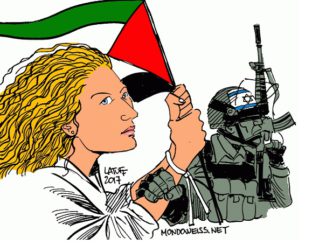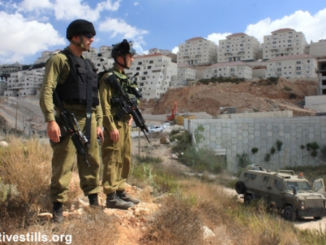
A team of British forensic researchers confirmed this week that 9-year-old Abdul Rahman Shteiwi was shot in the head on July 12 in the northern West Bank by a live bullet fired by Israeli soldiers and not by a rubber bullet, according to a press release by International Solidarity Movement (ISM).
Shteiwi was shot in the head while sitting outside his friend’s house during a protest in his village. He sustained severe brain damage and remains hospitalized more than three months after the shooting. The Israeli army claimed that soldiers did not use live fire that day and that Shtawi was most likely hit with a rubber-coated metal bullet.
British forensic researchers prove Israel used live fire to shoot Palestinian child Abd Shatawi in the head in July, leaving him severely brain damaged, cannot speak, remains hospitalized, shards of bullets still in his brain#GroupPalestine#قروب_فلسطيني
https://t.co/J2gmksbBk6 pic.twitter.com/stgaXlYeUJ— ?✦ Ᾰ ღ ✦___?? (@Betelgeuse100) October 23, 2019
A team from the London-based Forensic Architecture, which carried out an investigation into the incident at the request of ISM, concluded, after studying all kinds of evidence, that,
“Contrary to the repeated claims of Israeli officials, the available medical and image evidence, as well as witness testimony, strongly suggests that Abdul Rahman’s injuries were caused by live ammunition.”
As part of the investigation, said the report, US forensic experts were shown CT scans of Shteiwi’s brain which has over 100 bullet fragments still lodged in it.
@UN report: the Zionist regime killed 56 Palestinian children in 2018 & injured 2,674 others “in the context of demonstrations, clashes & search and arrest operations”
(In the photo: 9-year-old Abd el-Rahman Shatawi who was shot in the head by an Israeli sniper) pic.twitter.com/AGmpTmBlw5
— Asaf Ronel (@AsafRonel) July 27, 2019
From analyzing the scans, the experts said:
“Although they [rubber bullets] can indeed penetrate individuals, and are more likely to do so in juveniles who exhibit less dense bone, they are not known to fragment, especially to the extent visible in the CT scans.”
Instead, the experts said the level of fragmentation was “consistent with fragmentation seen in 5.56 mm [live] rounds.”
The shooting of 9-year old Palestinian boy Abdul Rahman Shteiwi is one of the latest in a long list of incidents in which children have been injured or killed by the ISF.#NotATarget Children must be given special protection & not be put at risk.
? https://t.co/b8bzpS8lvX pic.twitter.com/BhjsU1U68v
— UN Human Rights (@UNHumanRights) July 30, 2019
ISM activists present that day also witnessed soldiers firing live bullets at protesters.
Shteiwi’s family told ISM that they were not surprised by the army’s refusal to admit to using live fire.
Recently, Shteiwi was moved from a Tel Aviv hospital to Beit Jala in the West Bank after Israeli doctors said there was nothing else they could do.
Abdul Rahman Shteiwi, 10, remains in the Tel Hashomer Hospital in Tel Aviv, unable to speak or move his body, after he was shot in the head by Israeli forces in his village of Kafr Qaddum in the northern occupied West Bank. https://t.co/Lx4ZpRiL75
— Mondoweiss (@Mondoweiss) October 9, 2019
His family said:
“He can’t speak and no changes [to his condition] occurred since he was shot. The doctors say that his condition is still in danger and that a huge damage occurred in his brain because of the bullet.”
In the past three months alone, 100 Palestinian children have been shot with live ammunition. Despite these gross human rights violations, said ISM, governments around the world have remained silent on the Israeli army’s callous use of live fire against children.
(Wafa, PC, Social Media)








